New Comic Book Day: DOUBLE SIZED SUMMER SPECTACULAR
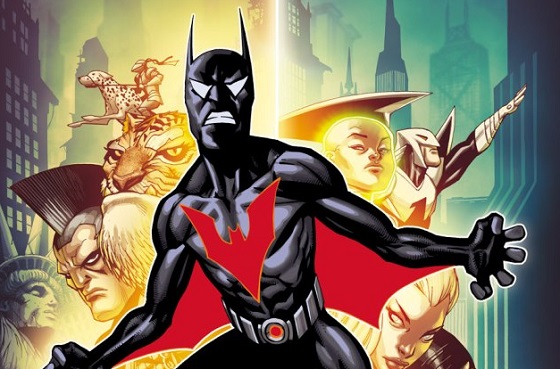 |
We’re a week out from San Diego Comic Con, and everybody and their mother is pushing out enormous comic news. Conveniently timed, too, since DC is a month past their post-Convergence launches, so following the latest happenings in comic books right now is like trying to follow election news the week of Halloween. In that spirit, we’ve got a SPECIAL DOUBLE-SIZED NEW COMIC BOOK DAY COLUMN WOOHOO! *throws confetti at monitor*. As soon as I shake all this glitter out of my keyboard, we’ll start with an interview with Dan Jurgens and Bernard Chang about Batman Beyond, their ongoing series about Tim Drake in the now-hard-canon future of the DCU. Then we’ll get to some reviews, because there were some awesome comics out this week. Join us below the fold for the column equivalent of a summer BBQ!
Dan Jurgens is a legend in the comics business. He’s been writing and drawing for more than 30 years, and his credits read like a list of DC’s biggest events – “The Death of Superman”, Zero Hour, 52, Futures End, Convergence – interspersed with time on flagship characters for both big superhero companies. Bernard Chang is a penciller most recently known for his work on Green Lantern Corps, with an extensive background in comic art as well as concept design. In the wake of DC’s latest crossover, Convergence, the two have come together to relaunch Batman Beyond with a twist – instead of Terry McGuinness, the future Batman we’ve known for years, Jurgens and Chang put Tim Drake in the Beyond suit and hurled him into a dystopian future ruled by Brother Eye, an artificial intelligence created by Bruce Wayne and Mr. Terrific who took over the world and eliminated almost all of the heroes from it. We had a chance to talk to Dan and Bernard about why they sent Tim to the future, the challenges of designing a near-future dystopia, and a Batman Beyond comic that’s more closely tied to the current-day Bat-books.
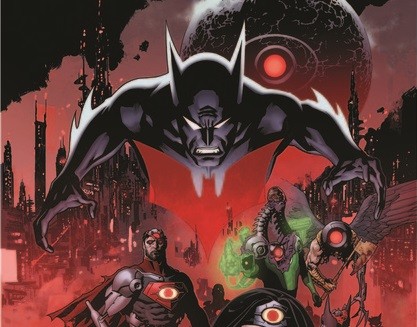 |
| DC Comics |
Jim Dandeneau: Dan, at the beginning of Futures End, did you know that this was where you were taking Tim?
Dan Jurgens: Not 100% for sure. We knew at the beginning of Futures End that we wanted to make Batman Beyond a part, a strong part of the DC Universe. And there was a thought at the beginning of Futures End that Tim Drake was going to end up wearing the Batman Beyond suit. The mechanics and how it would be done and everything like that were not quite in place at that time.
JD: Can you talk a little bit about the thought process behind why you guys felt this was the right choice for Tim?
DJ: Sure, and I think that covers actually a couple of things, and one is there have been several Batman Beyond titles in the past and they were all very good, and we wanted to make sure we weren’t just going to be retelling some of those stories. But then more to the point, we really knew that what we were going to set out to do is take one aspect of the DC future timeline which sort of includes Kamandi and the Great Disaster concept, and merge that with the Batman Beyond concept. And we thought a great way of exploring that is to take someone from the DCU present, in Tim Drake, and put him there so that we take those three different corners of the triangle, if you will, and put them together. So what we really have happening in this series and represented is DCU present, DCU future and Batman Beyond future, and we’re trying to put it all together.
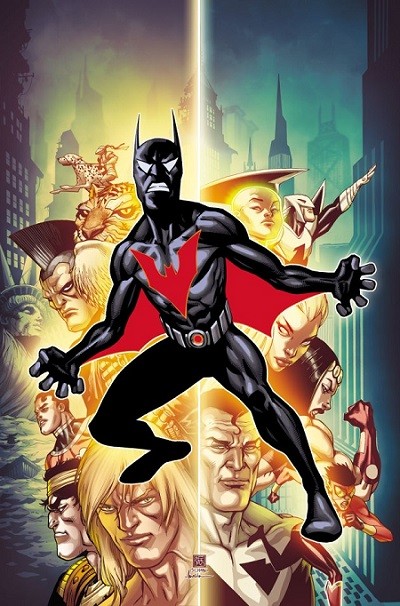 |
| DC Comics |
JD: You mentioned Kamandi and the Great Disaster. King Faraday and Command D were kind of left dangling at the end of Futures End, along with Fifty Sue. Are any of those loose ends stuff that you’re going to pick up in the future in Batman Beyond?
DJ: It’s certainly a possibility, but for the immediate present, I really think the best way to serve this series and to tell the story that we want to tell and the one that I think most fans also want to see is, “Let’s see Batman Beyond and let’s see what this world is now and how it all comes together,” because the future that we have now is different than the future we would’ve seen in Futures End #0. Things were restructured. That Earth 2 invasion never happened. So it’s a bit of a different world. Everybody gets to experience that together as they go forward and read the book.
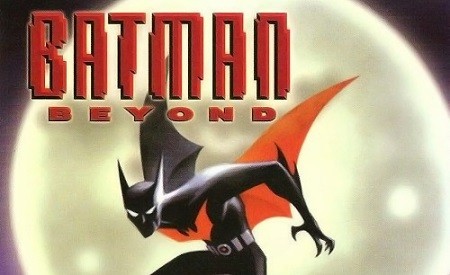 |
| Wikipedia |
JD: …You mentioned that it’s a different universe or a different world than even the one depicted in Futures End. It’s obviously also a very drastically different world from the Beyond cartoon. How much tension, I guess, do you feel…creative tension I guess is the right way of putting it…to play off of what’s come before? Bringing in some of the show’s mainstays like Dana or the old Justice League or even touching on Tim’s hinted future from the Return of the Joker movie?
DJ: Do you want to take that, Bernard?
Bernard Chang: Well, architecture-wise, I think that plays, Neo-Gotham and the rest of the post-apocalyptic world, plays a tremendous part in terms of story development. Environments are equally as important in terms of the story as any of the characters, whether it’s Tim or Barbara Gordon or Max. How you design and how you envision the future really creates a tremendous mood and dynamic experience as you’re reading the stories. So I think there’s a lot in play there. We also want to balance between, you can see a little of the characters that we were familiar with before, re-envisioned in a slightly different way…It’s not something that’s set in one particular moment and that’s it. The story progresses as we move from issue 1, 2, 3, 4. There’s also progress in the characters’ interactions with each other, too. At some point, imagine if you were Max and Tim shows up with your brother’s suit. How would you feel and would you be completely trusting of that person, initially? And how do those sentiments play out later on?
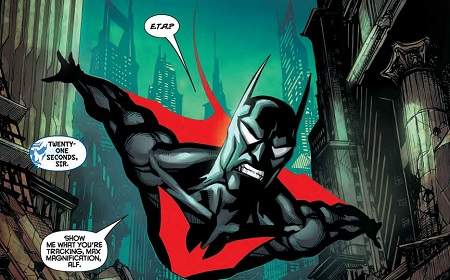 |
| DC Comics |
JD: Bernard, you mentioned architecture. You have an architecture background, right?
BC: Yes, I have a degree in architecture from the Pratt Institute.
JD: …So you’re coming in with kind of a blank slate a little bit, too, in that you’re building off of hints from the Futures End timeline that didn’t really happen, but how much does the architecture background and your formal education influence how you’re designing the world of the future?
BC: The most fun part is design for a lot of artists. I spend a lot of time, a good portion of the time designing things. to a certain point where I actually have to just stop and start drawing pages otherwise the book’s never going to come out. But I really get to envision where the Earth is, where the world is at some point 35 years in the future. It’s not that far out. And so with that respect, you still want futuristic or modern at the time structures and also how things are built and how things are made and how people view them and get around, but they also have to be in respect to what exists today right now in terms of technology and…lifestyle is not the right word, but…
JD: Yeah, how they live their lives, right?
BC: Yeah, exactly.
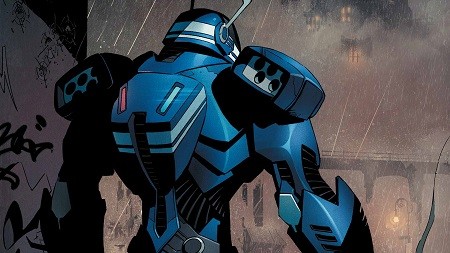 |
| DC Comics |
JD: We saw hints of it in [issue #1]that, Dan, that you mentioned that you wanted Beyond to be brought more closely into the main…Bat-universe. And we saw in [the latest]issue of Batman some more Powers stuff being seeded there. How much are you collaborating with, and this is for both of you, how much are you collaborating with the rest of the Bat-office in seeding stuff and playing off of each other?
DJ: Well I think, obviously we saw Barbara Gordon show up at the end of #1, and I’m going to give you a high five because you’re the first one who noticed the Powers connection in Batman #41 and how that’s going to potentially influence us. It’s one of the things we’re talking about, and we do have plans, and that’s going to play out over the next chunk of issues.
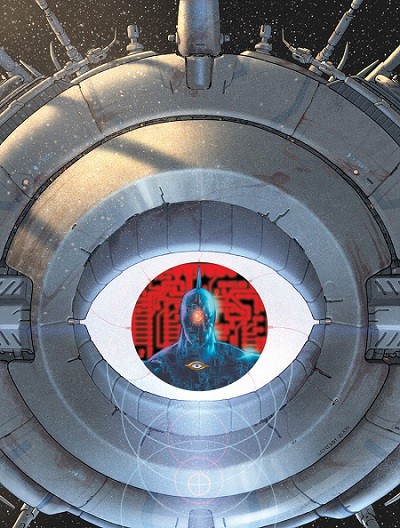 |
| DC Comics |
JD: In the first issue, we get the explanation for why the OMACs haven’t attacked Gotham. Is there a possibility that there are other spaces in the world that have been similarly untouched, and will we be travelling there?
DJ: One of the things that I have talked about with this book, and Bernard and I have chatted about this quite a lot, is we tend to think, and we’re all like this, that the rest of the world is pretty much like what our experience is in our own community or outside our own window. In reality, there are plenty of places on this planet where the internet does not exist, where people don’t have enough food, where they live a life that would seem to us to be something that represents a world of a couple hundred years ago. By the time we get to that future, 35 years from now, that is even more acute. And we are going to have very different environments on this Earth. Just because Brother Eye says “I have hit everything except Neo Gotham,” that doesn’t necessarily mean that is absolutely the truth.
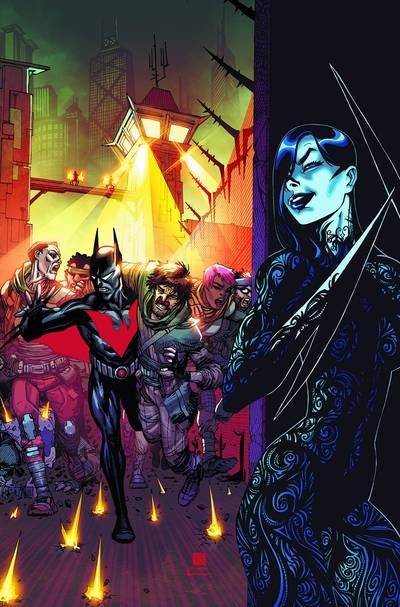 |
| DC Comics |
| Batman Beyond #2 – click to enlarge |
JD: [Bernard,] how much do you feel like your experience drawing the Green Lantern Corps has prepared you or influenced how you’re approaching Batman Beyond and this futuristic world?
BC: I think the two books are very different….Corps was about different alien environments, alien cultures, and Batman Beyond is really about the human experience. There’s a little bit of a slightly different approach in design….There’s a little bit of a different dynamic in terms of approaching designs. With Corps, you had to start all over every issue with 2 or 3 or 4 different alien environments. With Batman, there is a fundamental starting point, a foundation, but we get to as we explore different environments, different cities, different places, you really want to bring back the human element to a lot of the design work there. For the most part, I think, with Corps, the greatest experience I had was working with Marcello [Maiolo], who’s also the colorist on Batman Beyond, and he and I have begun to develop a nice visual dialogue. Not just working with each other, but in the final product and the final pages and books that are printed and readers can hold in their hands. I think that in itself, working in comics, too, for me, a lot about it too is the relationship that you develop with your teammates, whether it’s with Dan or with Marcello. Dan and I have been wanting to work with each other for quite a while now, and finally this project came along and both of our schedules, the stars aligned, and so I think that, in itself is probably the greater takeaway.
JD: How tight or loose do you guys work? Is it full script, or is it like, almost Marvel style?
DJ: Right now, we’re going full script. I think we look forward to the day that we can break free of that, but when you start building a series, just in order to make sure everybody is on the same page, we’re going full script for now. But we’ve talked about that, and I don’t think that’s going to be the permanent status of things by any means.
BC: I think ultimately, I do really much more enjoy working in a plot format. But the first few issues, definitely, because we’re setting up a dialogue, a vocabulary for this universe. And we want to make sure that we’re all on the same page before we get too further down the road. Because even in the first few issues, there’s a lot of stuff that’s interpretation, myself reading Dan’s scripts, and even with the visual notes, and the details and the reference that he includes, there’s a level of interpretation. And then from myself, from my work that goes to Marcello, there’s another level of interpretation. And we want to make sure that we’re all on the same page, especially at the very foundation, at the first floor of the series moving forward. There is some magic in the plot format, and I think we have the right team to tackle that. So I look forward to that.
JD: Thanks for talking with us!
You can pick up Batman Beyond #2 today at your friendly local comic shop or online via Comixology. Head on through to the next page for a look at some of the other comics out this week.
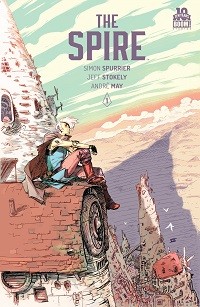 |
| BOOM! Studios |
The Spire #1 (BOOM! Studios)
Let’s get the obvious out of the way: if you haven’t bought Six Gun Gorilla despite my badgering, you’re missing out on a great story. The Spire reunites SGG‘s (hmm. That doesn’t really work, does it?) creative team of Si Spurrier and Jeff Stokely. I’ve gone on and on about Spurrier’s writing before, so I’ll spare you anything more untoward from me about Spurrier’s clever, hilarious, fun writing and just say it’s very good urban fantasy.
Stokely’s artistic flexibility is very impressive. Some of the characters look straight out of a ’50s Sunday paper comic strip; some like ’80s anime characters; Pug in the Garg-coop even looks like he was lifted from a political cartoon in a 19th-century newspaper. The art also shifts to straight up horror for a couple of panels, and the result is surprisingly effective. Unfortunately, there was a joke on the page before it that took a second to land, so I had my epiphany and started chuckling right when I was supposed to be fear-struck
If you liked Perdido Street Station, you’ll probably like this. If you liked 6GG (no, that sounds like the bra size of a really weird Page 3 girl DAMMIT JUST WRITE IT OUT, JIM) Six Gun Gorilla, you’ll definitely like this.
You can pick up The Spire #1 at your friendly local comic shop or online via Comixology.
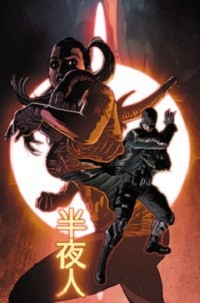 |
| DC Comics |
Midnighter #2 (DC Comics)
I just figured this book out. Not its popularity; that’s obvious. I have a tendency to be a little dense sometimes, and I can miss symbolism the first time through unless I’m punched in both ears with it until they explode.* The first issue was a delightful, violent, over-the-top action comic, well drawn and with a really likable main character, especially considering the very respectable body count he piles up in it. No, I figured out what Midnighter’s significance is.
The art on it is very good. Aco’s layouts in Midnighter #1 were great, reminiscent of David Aja on Iron Fist in how they emphasized the points of impact on the strikes when there were fight scenes. Alec Morgan jumps in for #2, and while his art looks a touch more hurried than the first issue’s, he follows Aco’s lead on layouts and style, and the result is still good. But that’s not what makes this a big deal, either.
I understand the parallels between superheroes and oppressed groups, how cape comics serve as a metaphor exclusion and otherness. Some of them are used that way more than others, and the parallels are frequently sketchy and forced once you dig down past a really high level. Midnighter flips the metaphor around completely. My favorite part of the first issue was how matter of fact Lucas was with his date about being a superhero. But if you replace all the times he talks about his hero career with him talking about his sexual orientation, you’re looking at a conversation gay people have probably each had thousands of times in their lives, and the plain, upfront tone he uses is a refreshing way to address it in a mainstream superhero book. Steve Orlando keeps that tone through the second issue, but he builds on the hero/mystery angle and works in some really outstanding action sequences. It’s a great comic.
*This is an actual example of the violence in this comic. It is magnificent.
You can pick up Midnighter #2 at your friendly local comic shop or online via Comixology.
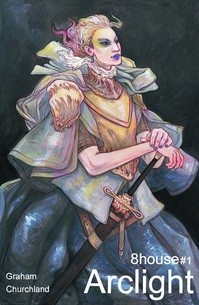 |
| Image Comics |
8House: Arclight #1 (Image Comics)
You can probably guess from reading the interview with Brandon yesterday that I really liked this comic. It’s a gorgeous, serene introduction to the 8house world that Graham is building.
I’m not really sure I understand why this issue had this effect on me, but I felt really calm reading it, when the story beats clearly show a more tense, tumultuous world. I honestly think it was the grand scope of Churchland’s art – most of what I’ve read from Graham is very dense and busy. Even when he’s not drawing it (like on Prophet), he packs so much information into his worldbuilding that his art partners make the story feel closer than Arclight does.
I think – and I’ll probably reread again once Arclight‘s story is done – what affected me the most is Churchland’s use of backgrounds. When they don’t add anything to the panel, they’re not there. There are several panels where the background is whited out, so the focus is entirely on the one piece of action in its borders. But when she pulls back the camera to establish the world, everything is huge and detailed. On those white (or sometimes greenish-grey) backgrounded panels, there’s something important happening that you need to pay attention to and not get swept through that moment.
This is a super granular level of nerdy for me, but when a comic is made well, the second or third time through it I really enjoy being reminded that I’m reading a Comic Book, with all of the quirks and subtleties that entails. Arclight is one of those comics.
You can pick up 8House: Arclight #1 at your friendly local comic shop or online via Comixology.
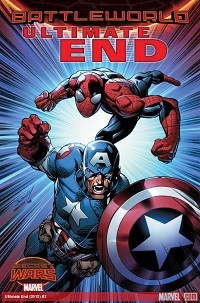 |
| Marvel.com |
Ultimate End #3 (Marvel Comics)
I feel like half the time when I talk about Bendis comics, I’m saying “He’s still got it!” And the other half I’m saying “I know he’s still got it, but…” This one is the latter. Ultimate End is almost everything people point to when they complain about event comics. Impenetrable, drab, continuity free both internally and within the larger Secret Wars story, this book is hyped as an end point for the Ultimate universe, but could have characters from any adjacent Earth posing as Ultimate characters. Once you move past covers and solicit text, nothing about this comic makes any sense.
I know that there are characters who look like the 616 and Ultimate versions. I know SPOILERS one of the Hawkeyes got greased by a Thor from the Thor corps, and people keep referring to God Doom, placing this series somewhere after Secret Wars #2. I also know that 2 Iron Mans are also there, when 616 Tony is still off the board in the main Secret Wars series and it’ll presumably be a big deal when he rolls in. And I can’t imagine why this book would be allowed to sap the drama from that moment. So I have to assume that it exists in some kind of continuity black hole at the center of Battleworld, where everyone talks in Mamet patter and nothing has any real significance. Also, a word on the art: I know Mark Bagley is a skilled penciller, but I wish the final product didn’t look like he had someplace better to be while he was drawing it.
You can pick up Ultimate End #3 at your friendly local comic shop or online via Comixology.
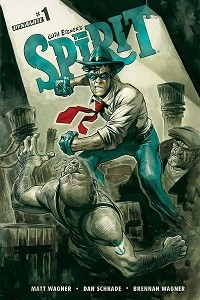 |
| Dynamite Comics |
Will Eisner’s The Spirit #1 (Dynamite Comics)
Dynamite’s relaunch of the legendary comic starts this week, and the story picks up with the Spirit missing for 2 years. Matt Wagner uses that framing device to quickly retell Denny Colt’s origin and introduce his supporting characters, and he does a good job of zipping through the exposition without feeling rushed at all.
Most of the plot and action come from Sam Strunk and Ebony White, private investigators who have been in Spirit comics forever (I think – I’m not really well versed on this series besides “Will Eisner and Darwyn Cooke draw gud”), on the case that they crack and their decision to find out what happened to him. This is pitched as an ongoing, so spoilers, I guess.
Matt Wagner writes ’40s noir dialogue without sounding trite. Schkade’s art goes straight for cartoony, avoiding most of the noir trappings you’d expect to see in a story like this, and it’s pretty good. He doesn’t get a ton of action to work with, but what he does draw is solid. His faces are expressive, and the body language looks natural for people who sound in my head like they all talk with a very slight Edward G. Robinson lilt. And I know it’s an easy joke, but having people call “Strunk & White Investigators” for grammar lessons made me laugh.
You can pick up Will Eisner’s The Spirit #1 at your friendly local comic shop or online via Comixology.
ONE THAT GOT AWAY
Every week there are way too many comics for me to read and keep track of. So in every column, I’m going to take a look at a book that came out in the last few weeks, but that I only just had a chance to read.
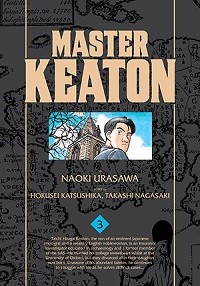 |
| Viz Media |
This week, it’s Master Keaton volume 3, one of the most delightful comics I’ve read in a long time. Taichi Hiraga Keaton is the son of a Japanese zoologist and a British noblewoman. He’s an Oxford educated ex-SAS member who works part time as an insurance investigator, travelling the world looking for insurance fraud and an archaeologist trying to hold down low-level faculty positions at various universities in Japan, while also pining for his ex-wife and being a parent to a precocious daughter. It’s a fairly convoluted backstory, but a really simple character.
It’s not really a well-kept secret that I tend to enjoy “aw shucks” nice-guy protagonists in my fiction. Not that there isn’t a place for badass antiheroes or smartass rogues, but the ones that stick with me the most always have this pure, uncorruptible core. Keaton is exactly that – he’s Indiana Jones, but nerdy-sweet instead of a swashbuckler. My favorite thing about the character is how he always makes his incredible badassery look like an accident, and then makes a point to care about the bad guys after the fact. These stories go out of their way to de-emphasize his martial abilities and play up his intellect – not even his tactical acumen, but his skills of observation and deduction, coupled with very strong empathy. This is shaping up to be one of my all time favorite stories.
You can pick up Master Keaton volume 3 at your friendly local comic shop.
That’s what I’m reading this week. What are you picking up?
